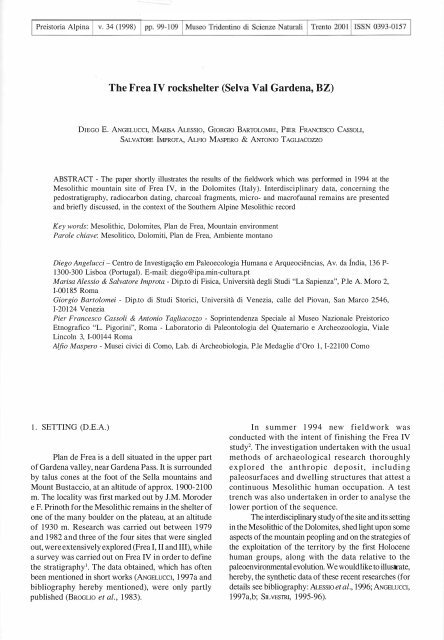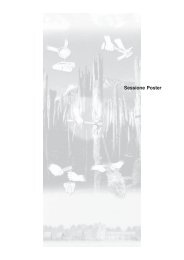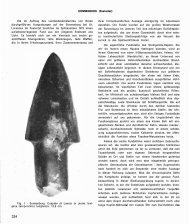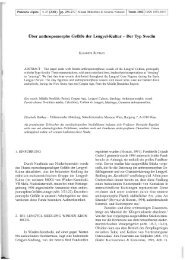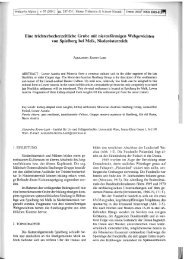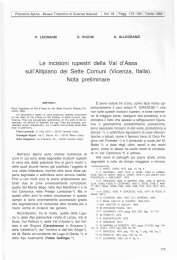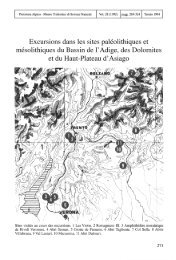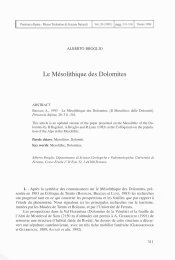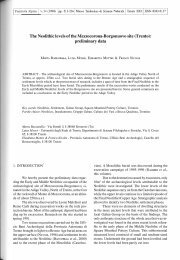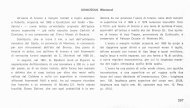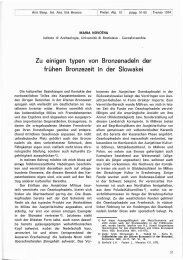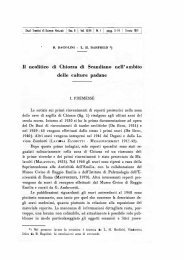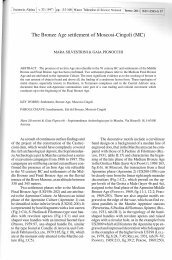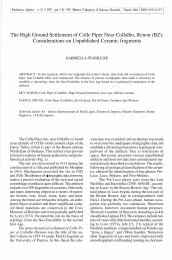The Frea IV rockshelter (Selva V al Gardena, BZ) - Laboratorio ...
The Frea IV rockshelter (Selva V al Gardena, BZ) - Laboratorio ...
The Frea IV rockshelter (Selva V al Gardena, BZ) - Laboratorio ...
Create successful ePaper yourself
Turn your PDF publications into a flip-book with our unique Google optimized e-Paper software.
Preistoria Alpina v. 34 (1998)<br />
<strong>The</strong> <strong>Frea</strong> <strong>IV</strong> <strong>rockshelter</strong> (<strong>Selva</strong> V <strong>al</strong> <strong>Gardena</strong>, <strong>BZ</strong>)<br />
DIEGO E. ANGELUCCI, MARISA ALESsro, GroRGIO BARTOLOMEI, PIER FRANcESco CASsou,<br />
SALVATORE IMPROTA, ALFIO MASPERO & ANTONIO TAGLIACOZZO<br />
ABSTRACT - <strong>The</strong> paper shortly illustrates the results of the fieldwork which was performed in 1994 at the<br />
Mesolithic mountain site of <strong>Frea</strong> <strong>IV</strong>, in the Dolomites (It<strong>al</strong>y). Interdisciplinary data, concerning the<br />
pedostratigraphy, radiocarbon dating, charco<strong>al</strong> fragments, micro- and macrofaun<strong>al</strong> remains are presented<br />
and briefly discussed, in the context of the Southern Alpine Mesolithic record<br />
Key words: Mesolithic, Dolomites, Plan de <strong>Frea</strong>, Mountain environment<br />
Parole chiave: Mesolitico, Dolomiti, Plan de <strong>Frea</strong>, Ambiente montano<br />
Diego Angelucci - Centro de Investigac;:ao em P<strong>al</strong>eoecologia Humana e Arqueociencias, Av. da India, 136 P-<br />
1300-300 Lisboa (Portug<strong>al</strong>). E-mail: diego@ipa.min-cultura.pt<br />
Marisa Alessio & S<strong>al</strong>vatore Improta - Dip.to di Fisica, Universita deg1i Studi "La Sapienza", P.le A. Moro 2,<br />
I -00185 Roma<br />
Giorgio Bartolomei - Dip.to di Studi Storici, Universita di Venezia, c<strong>al</strong>le del Piovan, San Marco 2546,<br />
1-20124 Venezia<br />
Pier Francesco Cassoli & Antonio Tagliacozzo - Soprintendenza Speci<strong>al</strong>e <strong>al</strong> Museo Nazion<strong>al</strong>e Preistorico<br />
Etnografico "L. Pigorini", Roma - <strong>Laboratorio</strong> di P<strong>al</strong>eontologia del Quaternario e Archeozoologia, Via1e<br />
Lincoln 3, 1-00144 Roma<br />
Alfio Maspero - Musei civici di Como, Lab. di Archeobiologia, P.le Medaglie d'Oro 1, 1-22100 Como<br />
1. SETTING (D.E.A.)<br />
Plan de <strong>Frea</strong> is a dell situated in the upper part<br />
of <strong>Gardena</strong> v<strong>al</strong>ley, near <strong>Gardena</strong> Pass. It is surrounded<br />
by t<strong>al</strong>us cones at the foot of the Sella mountains and<br />
Mount Bustaccio, at an <strong>al</strong>titude of approx. 1900-2100<br />
m. <strong>The</strong> loc<strong>al</strong>ity was first marked out by J.M. Moroder<br />
e F. Prinoth for the Mesolithic remains in the shelter of<br />
one of the many boulder on the plateau, at an <strong>al</strong>titude<br />
of 1930 m. Research was carried out between 1979<br />
and 1982 and three of the four sites that were singled<br />
out, were extensively explored (<strong>Frea</strong> I, II and Ill), while<br />
a survey was carried out on <strong>Frea</strong> <strong>IV</strong> in order to define<br />
the stratigraphy1• <strong>The</strong> data obtained, which has often<br />
been mentioned in short works (ANGELUCCI, 1997a and<br />
bibliography hereby mentioned), were only partly<br />
published (BROGLIO et <strong>al</strong>., 1983).<br />
In summer 1994 new fieldwork was<br />
conducted with the intent of finishing the <strong>Frea</strong> <strong>IV</strong><br />
study2• <strong>The</strong> investigation undertaken with the usu<strong>al</strong><br />
methods of archaeologic<strong>al</strong> research thoroughly<br />
explored the anthropic deposit, including<br />
p<strong>al</strong>eosurfaces and dwelling structures that attest a<br />
continuous Mesolithic human occupation. A test<br />
trench was <strong>al</strong>so undertaken in order to an<strong>al</strong>yse the<br />
lower portion of the sequence.<br />
<strong>The</strong> interdisciplinary study of the site and its setting<br />
in the Mesolithic of the Dolomites, shed light upon some<br />
aspects of the mountain peopling and on the strategies of<br />
the exploitation of the territory by the first Holocene<br />
human groups, <strong>al</strong>ong with the data relative to the<br />
p<strong>al</strong>eoenvironment<strong>al</strong> evolution. We would like to illustrate,<br />
hereby, the synthetic data of these recent researches (for<br />
details see bibliography: ALEssro et <strong>al</strong>., 1996; ANGELuccr,<br />
1997a,b; SJLVES1RI, 1995-96).
100<br />
2. STRATIGRAPHY AND CHRONOLOGY:<br />
OUTLINE (D.E.A., M.A., S.I.)<br />
<strong>Frea</strong> <strong>IV</strong> is situated on the SE corner of the boulder,<br />
where the protrusion forms a shelter of about 20<br />
m 2 surrounded by blocks f<strong>al</strong>len from the roof. Even<br />
though it is restricted, the preserved sequence is distinguished<br />
for its variability, which testifies the exception<strong>al</strong><br />
microenvironment of the <strong>rockshelter</strong>. <strong>The</strong> explored<br />
part, which is about 150 cm thick (Fig.1), is<br />
divided in six pedostratigraphic units (CS) and is summarily<br />
described (ALESSIO et <strong>al</strong>., 1996; ANGELUCCI,<br />
1997a).<br />
A reworked layer (CS1) and the present day A<br />
horizon (CS2) can be distinguished on the surface.<br />
CS3, which is about 50 cm thick, characterizes the<br />
main body of the anthropic stratification and is articulated<br />
in various units (Fig. 1). <strong>The</strong> upper pedogenized<br />
part (unit 3A) was divided into two artifici<strong>al</strong> cuts.<br />
<strong>The</strong> units marked 3B show strongly anthropic units<br />
of different characters. <strong>The</strong>se layers are less subject<br />
to pedoturbation, which has obliterated the interfaces<br />
of the upper units of the sequence, and contain<br />
anthropic structures (ALESSIO et <strong>al</strong>., 1996:146-147).<br />
Unit 3BII is possibly a living floor in a bad state of<br />
preservation. Evident structures are found on the living<br />
floor 3B<strong>IV</strong> (Fig.2), which fills up a depression<br />
delimited by an artifici<strong>al</strong> cut made in ancient times.<br />
At its foot there are two dug-out hearths - one of which<br />
has a complex filling - and possibly a post-hole3• CS3<br />
lies on a thick succession of deposits coming mainly<br />
from the slope, without anthropic deposits, and consisting<br />
of various facies (CS4 ). Two hearths were uncovered<br />
in the base portion (CS5). <strong>The</strong>y are partly<br />
deformed and cut into US4. <strong>The</strong> lowest unit to be<br />
excavated was US6, a carbonate clastic breccia in<br />
silty-clayey matrix.<br />
<strong>The</strong> <strong>Frea</strong> <strong>IV</strong> sequence underwent convention<strong>al</strong><br />
radiocarbon dating on dry carbon specimens (Fig.3;<br />
ALEss1o et <strong>al</strong>., 1996).<br />
On the basis of the stratigraphic and radiometric<br />
data the following occupation<strong>al</strong> phases were distinguished:<br />
F1 (unit 5, 4base): on a pedosedimentary<br />
basis, datable from 9000-8000 BC, even though the<br />
average older measures of US3B<strong>IV</strong> suggest the dating<br />
as 9000 BC, placing the first sporadic human occupation<br />
in the middle Prebore<strong>al</strong>; F2 (unit 3B<strong>IV</strong>, 3C):<br />
dated around 9000 BC; F3 (US3BIII): dated around<br />
the beginning of the IX millennium BC (middle-late<br />
Prebore<strong>al</strong>); F4 (US3BII): dated the first h<strong>al</strong>f of the<br />
VIII millennium BC, on the Prebore<strong>al</strong>-Bore<strong>al</strong> limit;<br />
F5 (unit 3BI, 3AII, 3AI): includes units that are not<br />
contemporary and have been homogeneously incorporated<br />
as a result of pedoturbation; dating is not possible,<br />
but it is clear that it is attributable to the Mesolithic<br />
period; F6: includes ceramic findings gath-<br />
ered from US3A that attest the presence of man in the<br />
post-Mesolithic period. FO indicates pieces of unknown<br />
or unspecified origin.<br />
3. ECOFACTS<br />
3.1. Charco<strong>al</strong>s (A.M.)<br />
Only a few specimens have been determined up<br />
till now. In US5 the charco<strong>al</strong> fragments mainly belong<br />
to Juniperus sp. and to the Pinus sylvestris/mugo<br />
anthracologic<strong>al</strong> type. <strong>The</strong> most common species in US4<br />
are Larix decidua Mill., followed by Pinus cembra L.<br />
and by a few fragments of Pinus sylvestris/mugo. In<br />
unit 4, the associations which have been distinguished<br />
at a preliminary stage indicate the transition from an<br />
open environment to a forest present near the site4.<br />
3.2. Macrofaunas (P.F.C., A.T.)<br />
About 4000 bone remains, of which 3,200 were<br />
undetermined microfragments, were discovered during<br />
the excavation.<br />
<strong>The</strong> surfaces of the remains present different<br />
states of preservation. Some specimens show wellpreserved<br />
surfaces and others presenting abrasions that<br />
removed the origin<strong>al</strong> surface of the bone and yet others<br />
that have been damaged as a result of the dissolution of<br />
carbonates. <strong>The</strong> variable state of preservation of the<br />
remains coming from the same unit can be due to the<br />
length of time they have been buried. <strong>The</strong> most damaged<br />
bones were those that were exposed for longer periods<br />
to weathering agents. Many remains were heavily<br />
marked by roots. Only one specimen showed rodent<br />
gnaw marks.<br />
<strong>The</strong> an<strong>al</strong>yses were carried out on 797 remains<br />
and identification, not <strong>al</strong>ways possible at the species<br />
level, was done for 205 elements. <strong>The</strong> most abundant<br />
remains, with similar percentages, belong to Cervus<br />
elaphus (37.6%) and to Capra ibex (34.6%). <strong>The</strong>re<br />
were abundant remains of a sm<strong>al</strong>l Lagomorph ( 48, par<br />
to 23.4%), probably Lepus cf timidus, and very few<br />
remains of wild boar, bear, bird and fish (Fig.4).<br />
Considering the remains of each unit as belonging<br />
to different individu<strong>al</strong>s, both red deer and ibex are<br />
represented by a minimum number of 11 individu<strong>al</strong>s5.<br />
If approximately the same amount of deer and ibex were<br />
hunted, then the hunting strategy must have been<br />
different because the deer are mainly represented by<br />
young anim<strong>al</strong>s whereas the ibex by adults (Fig.4)6• <strong>The</strong><br />
sm<strong>al</strong>l sample an<strong>al</strong>yzed does not <strong>al</strong>low to ev<strong>al</strong>uate<br />
possible strategies of carcass processing. Red deer and
ibex are represented by elements of the whole skeleton,<br />
but with a prev<strong>al</strong>ence of loose teeth and dist<strong>al</strong> limb<br />
bones, such as, ph<strong>al</strong>anges and metapodi<strong>al</strong>s (Fig.5).<br />
<strong>The</strong>re are no horns/antlers, atlases, axes, scapulae or<br />
astrag<strong>al</strong>i and in gener<strong>al</strong> there are fewer bones of the<br />
fore limb than of the hind limb; there are very few<br />
specimens of axi<strong>al</strong> skeleton. <strong>The</strong>re are traces of human<br />
action on some of the specimens (cut marks and impact<br />
marks) proving that these anim<strong>al</strong>s were exploited. <strong>The</strong>re<br />
are no complete red deer bones and even the ph<strong>al</strong>anges<br />
have been intention<strong>al</strong>ly fractured. <strong>The</strong> only intact bones<br />
of ibex are a few short bones of the dist<strong>al</strong> limbs (carp<strong>al</strong>s,<br />
tars<strong>al</strong>s and ph<strong>al</strong>anges), but even some of these<br />
are fractured. For the moment, impact marks have been<br />
identified on the diaphyses red deer humeri and femurs<br />
and on one ibex metacarpus. Striae caused by lithic<br />
tools are present on one red deer hyoid bone and humeri<br />
and on one ibex hyoid bone and ulna.<br />
In US3BII, the presence of elements that can be<br />
articulated is of great interest: a scafocuboid and its<br />
cuneiforms of an ibex, or the refitting of red deer bones<br />
broken in ancient times (humerus and femurf. <strong>The</strong><br />
remains of sm<strong>al</strong>l hares are mainly loose teeth and rarely<br />
pieces of the skull and refer to 8 adult individu<strong>al</strong>s.<br />
A fragment of a left fibula of Sus scrofa was<br />
found in US3B<strong>IV</strong>. A fibula fragment of Ursus arctos<br />
came from the same unit; other 3 remains of bears<br />
(one V metacarpus, a fragment of tibia diaphysis<br />
and probably an upper P4 fragment) came from<br />
US3BIII.<br />
In the bone assemblage there are three remains<br />
of birds, but only one termin<strong>al</strong> ph<strong>al</strong>ange (claw ph<strong>al</strong>ange)<br />
from US3BII was attributed to a G<strong>al</strong>liform of<br />
the Tetraonide family, probably a white partridge<br />
(Lagopus mutus). <strong>The</strong> only fish remains was one<br />
operculum from US3AII, tentatively referred to a<br />
Cyprinidae.<br />
<strong>The</strong> faun<strong>al</strong> data indicate that the human occupation<br />
of the <strong>rockshelter</strong> was linked to ibex and red deer<br />
hunting. <strong>The</strong> site was used from the beginning of the<br />
summer to the end of autumn, as can be proved by the<br />
presence of red deer and ibex killed at the age of about<br />
two to six months, corresponding to the present months<br />
of July-November. <strong>The</strong> red deer were about one to two<br />
years old and were probably hunted in May-June. <strong>The</strong><br />
faun<strong>al</strong> assemblage reflects a mixed environment with<br />
<strong>al</strong>pine prairies and wide rocky areas (ibex and hares),<br />
but <strong>al</strong>so with bush-forest developments on the fringes<br />
and at lower <strong>al</strong>titudes where herds of red deer lived and<br />
where bears and wild boars sought refuge.<br />
3.3. Micromamm<strong>al</strong>s (G.B.)<br />
Micromamm<strong>al</strong> remains are scarce and amount<br />
to 137 distinguishable fragments. <strong>The</strong> study of these<br />
101<br />
remains does not reve<strong>al</strong> great differences between the<br />
different phases of human occupation of the site.<br />
<strong>The</strong> Insectivores are well represented (12-22%)<br />
by Soricidae, comprising the prevailing Sorex araneus<br />
and <strong>al</strong>so Sorex <strong>al</strong>pinus, Sorex minutus, Neomys sp. and<br />
moles. Rodents are abundant (78-88 % ), mainly including<br />
the Clethrionomys glareolus, while the arbore<strong>al</strong><br />
species are rare and few between, represented by Sciurus<br />
vulgaris, Dryomys nitedula andApodemus sp.(rare). <strong>The</strong><br />
Microtinae type is scarce; two specimens of Microtus<br />
arv<strong>al</strong>is are present in US3B<strong>IV</strong> (out of a tot<strong>al</strong> of three<br />
micromamm<strong>al</strong> remains in the unit), while this type is not<br />
to be found in the other units; Microtus niv<strong>al</strong>is is frequent<br />
in US3BII and US3BI but rare in US3A; the percentage<br />
of Microtus (Pitymys) sp. becomes more significant<br />
further up. <strong>The</strong> faun<strong>al</strong> association is probably hindered<br />
by the different lithologic<strong>al</strong> nature of the two slopes and<br />
by the bottom v<strong>al</strong>ley richly supplied with running waters<br />
on a rather impermeable earth substrata. In trying to<br />
give a p<strong>al</strong>ecologic<strong>al</strong> interpretation of this, it can be<br />
supposed that the <strong>al</strong>pine environment, rich with<br />
herbaceous plants, shrubs and trees, changed from a dry<br />
habitat to a more humid one. <strong>The</strong> arbore<strong>al</strong> species could<br />
reve<strong>al</strong> the presence of a forest environment at a lower<br />
<strong>al</strong>titude. Due to the fact that it is a highland site, the<br />
p<strong>al</strong>ecologic<strong>al</strong> interpretation of the pellets of birds of prey<br />
that lived in the <strong>rockshelter</strong> must be carefully considered,<br />
as there is no bibliographic<strong>al</strong> reference.<br />
4. THE LITHIC ASSEMBLAGES (D.E.A.)<br />
<strong>The</strong> lithic assemblage of <strong>Frea</strong> <strong>IV</strong> is not very<br />
abundant and we hereby supply the gener<strong>al</strong> data (see<br />
SILVES1RI, 1995-96; ANGELUCCI, 1997a); it includes precores,<br />
cores, retouched pieces, shatter and unretouched<br />
flaking products8•<br />
An<strong>al</strong>yses on the unretouched products were<br />
carried out on a morphologic<strong>al</strong>, typometric and technologic<strong>al</strong><br />
basis, creating a specific database. <strong>The</strong><br />
collection includes about 600 pieces, mainly fragmented<br />
(about 60%); the cortic<strong>al</strong> ones or the ones with<br />
natur<strong>al</strong> surfaces are scarce in <strong>al</strong>l the phases (about 5%).<br />
Considering the materi<strong>al</strong> used, there is an increase of<br />
bladelets products, from 44% in F2 to more than 66%<br />
in F5 towards the higher parts. Among the used<br />
lithotypes9, flint from the Veneto Series prevails (more<br />
than 90% of the determined lithologies), whereas the<br />
loc<strong>al</strong> flint is scarce and hy<strong>al</strong>ine quartz is occasion<strong>al</strong>ly<br />
found (about 1% ). <strong>The</strong> data referring to the morphology<br />
of the materi<strong>al</strong>s are the same as those found in other<br />
Mesolithic sequences of the region, and particularly at<br />
Romagnano Ill (Brsr et <strong>al</strong>., 1987). Transvers<strong>al</strong><br />
asymmetric<strong>al</strong> sections and smooth butts prevail,
102<br />
especi<strong>al</strong>ly in the ancient phases (F2 and F3) with rather<br />
irregular edges. <strong>The</strong>y usu<strong>al</strong>ly have flat ventr<strong>al</strong> faces<br />
and show par<strong>al</strong>lel unidirection<strong>al</strong> scars on the dors<strong>al</strong><br />
face, matching the data on the cores. <strong>The</strong> gener<strong>al</strong> outline<br />
suggests and intense exploitation of cores and other<br />
flint substitutes perhaps due to the fact that there were<br />
no sources of flint in the environs and that "partlyworked<br />
" raw materi<strong>al</strong>s were imported to the site.<br />
Two fragmented pre-cores and 41 cores were<br />
recovered. <strong>The</strong> majority of these were of loc<strong>al</strong> lithic<br />
industries; the Scaglia Rossa reddish-brown flint prevails<br />
(13 cores), followed by the "Biancone" brown or<br />
grey flint (5 pieces). Only 3 out of the 36 distinguishable<br />
pieces were produced by loc<strong>al</strong> lithic industries9•<br />
<strong>The</strong> cores are sm<strong>al</strong>l and often completely used; only<br />
few usable cores feature signs of flaking. <strong>The</strong> forms<br />
are gener<strong>al</strong>ly simple and not much attention is paid to<br />
the manufacturing. <strong>The</strong> bladelets cores prevail in <strong>al</strong>l<br />
the sequence and there are fewer flake cores (Fig.6).<br />
<strong>The</strong> scarce assemblage does not <strong>al</strong>low to distinguish<br />
the variations of the structures of the single phases; the<br />
absence of flake cores, the substanti<strong>al</strong> stability of the<br />
structure and the higher frequency of bladelets cores<br />
and two pre-cores is however surprising if compared<br />
to Romagnano III (BRoGuo & KozwwsKI, 1984).<br />
<strong>The</strong> collection amounts to 127 tools and 23 1<br />
micro lithic tools, an<strong>al</strong>ysed according to the Romagnano<br />
III typologic<strong>al</strong> list (BRoGuo & KoZLowsKI, 1984).<br />
It is evident that F5 is much richer and that the<br />
other phases are relatively poor. <strong>The</strong> rnicroliths are more<br />
abundant than the tools in <strong>al</strong>l the sequence; they are<br />
very abundant in phases 2, 3, and 4 and decrease in F5<br />
even though they still prevail (Fig.7).<br />
<strong>The</strong> most abundant tools are the retouched<br />
flakes that amount to over 30% of the collection; these<br />
are followed by the endscrapers (20-24%) and the<br />
retouched blades (about 20%). <strong>The</strong> other classes are<br />
scarcely represented and there is no evidence of points<br />
and composite tools in the whole collection (Fig.8).<br />
Even though the collection is poor, there are some<br />
particular features. Among the endscrapers - mainly<br />
found in F5, the only phase where there are some forms<br />
on flake - there are short and very short front<strong>al</strong><br />
endscrapers, as well as endscrapers on flat supports<br />
and flint roof-shaped scrapers. <strong>The</strong> skrobacz (9<br />
specimens) and the raclette (9 specimens) prevail among<br />
the retouched flakes, <strong>al</strong>ong with abrupt retouched bowl<br />
flakes. <strong>The</strong>re are only 4 burins: 2 simple, later<strong>al</strong>,<br />
fractured ones, one of which removed from a burin and<br />
two short and thick ones, one of which is multiple. Four<br />
of the truncated blades feature slightly oblique and<br />
concave truncated ends (2 in F4 and 2 in F5).<br />
<strong>The</strong> retouched blades are abundant in the upper<br />
sequence; notched blades prevail (13 specimens, 7 of<br />
which present direct notch on one side), but the blades<br />
retouched on only one side are <strong>al</strong>so well represented (7<br />
pieces). Only 5 of the pieces were attributed to bees<br />
and borer groups, which were only present in F5. <strong>The</strong>se<br />
are 4 bees, 2 of which on blade support and 1 fragment<br />
of a symmetric<strong>al</strong> axi<strong>al</strong> borer on blade. <strong>The</strong>re are 3 partly<br />
backed knives (2 in dist<strong>al</strong> position, one of which has a<br />
notch on the base of the reverse side and the other one<br />
in proxim<strong>al</strong> position) and a completely backed knife<br />
with a notch at the base of the opposite side. Fin<strong>al</strong>ly,<br />
there are 2 pieces ecaillees.<br />
<strong>The</strong> triangles are the most represented class of<br />
micro lithic tools, followed by the double backed points,<br />
by the segments and by points on larninar flakes. <strong>The</strong><br />
other classes are scarce, and unidentifiable fragments<br />
are abundant. <strong>The</strong> classification suggests some<br />
structur<strong>al</strong> changes from the ancient phase to the recent<br />
ones (Fig. 9): <strong>The</strong> decrease in points on laminar flakes<br />
and the discontinuous decrease in segments, the abrupt<br />
decrease in double-backed points in F5 ; the increase in<br />
backed and truncated bladelets, the increase in triangles,<br />
which prevail among the microliths in F4 and F5; the<br />
presence of trapezes. <strong>The</strong>refore, the structure is quite<br />
stable in F2 and F3, followed by a first change in F4,<br />
where backed and truncated bladelets appear, as well<br />
as one trapeze with a consequent decrease mainly in<br />
blade points. <strong>The</strong>re is a consistent variation in F5 with<br />
a drastic reduction of double-backed points <strong>al</strong>ong with<br />
the increase in triangles and trapezes.<br />
<strong>The</strong> collection consists of: 10 truncated points,<br />
3 of which are near the natur<strong>al</strong> dist<strong>al</strong> end, five dist<strong>al</strong><br />
short ones and one on the support axis; 10 backed blade<br />
points, 5 with complete, curved backs with dist<strong>al</strong> point;<br />
12 backed points, including 5 with complete back, 3<br />
double pointed, with double symmetric<strong>al</strong> backs and 3<br />
with arched backs near the point. Most of the segments<br />
have straight backs, with a natur<strong>al</strong> opposite edge or<br />
with a parti<strong>al</strong>ly retouched one; there is <strong>al</strong>so a segment<br />
with sinusoid<strong>al</strong> back, one trapeze with tot<strong>al</strong> retouch<br />
and there are two specimens with bevel ends, one with<br />
a natur<strong>al</strong> base and the other with a retouched base.<br />
<strong>The</strong>re is a slight increase in the amount of longer forms<br />
in the tot<strong>al</strong> amount of segments in F5 . <strong>The</strong> backed<br />
bladelets with truncated ends <strong>al</strong>l feature one back and<br />
an oblique truncation forming an obtuse angle.<br />
As for triangles, the number of isosceles triangles<br />
decrease towards the upper part and become <strong>al</strong>most<br />
insignificant (57% in F2, 13% in F5), because of<br />
the increase in sc<strong>al</strong>ene forms (due to the significant<br />
appearance oflong sc<strong>al</strong>ene triangles with long bases),<br />
which are more frequent from F3 onwards, and of long<br />
triangles with short base. <strong>The</strong> double-backed points are<br />
abundant from F2 to F4 and decrease in number in F5,<br />
where short types are more common. <strong>The</strong> longer forms<br />
gener<strong>al</strong>ly have two entire converging backs with bipolar<br />
retouch. <strong>The</strong> shorter ones mainly feature two backs, a<br />
natur<strong>al</strong> base and tapered end. <strong>The</strong> trapezoid<strong>al</strong> forms<br />
were found mainly in F5 ; there are short and very short
forms (3 and 2 pieces, one with a truncated end struck<br />
with one blow), and there is <strong>al</strong>so 1 asymmetric<strong>al</strong> oblique<br />
concave trapeze and 1 long asymmetric<strong>al</strong> trapeze with<br />
a simple base. Fin<strong>al</strong>ly, there are 5 bladelets with tot<strong>al</strong><br />
abrupt retouch of the edge and one point. <strong>The</strong>re are<br />
<strong>al</strong>so 187 microburins with a majority of simple ones<br />
and some backed types; there are various unfinished<br />
microlithic tools. <strong>The</strong> average microburins/microlithic<br />
tools ratio is 0.89 ranging from 0.70 (F4) and 1.05<br />
(F3).<br />
<strong>The</strong> <strong>Frea</strong> <strong>IV</strong> sequence has evident typologic<strong>al</strong><br />
par<strong>al</strong>lelisms with other Mesolithic industries of the<br />
River Adige basin with regard to the gener<strong>al</strong> structure<br />
and the changes in the various phases. Phases 2<br />
and 3 have a significant stable structure and the differences<br />
are linked to the scarce quantities rather than<br />
to the re<strong>al</strong> changes in the two phases. Among the<br />
microlithic tools, there is a predominance of triangles,<br />
segments, double-backed points and lamellar<br />
blade points, in particular truncated points. Among<br />
the triangles, the isosceles forms are most common.<br />
<strong>The</strong> double-backed points and the segments are mostly<br />
represented by long-form types. <strong>The</strong>se parameters<br />
enable to attribute the assemblages of F2 and F3 to<br />
two different periods of the early Sauveterrian culture,<br />
as was confirmed by the dates. In phase 4 there is an<br />
increase in truncated and retouched blades <strong>al</strong>ong with<br />
a decrease in retouched flakes. On the whole triangles<br />
increase; the number of isosceles forms decrease and<br />
the sc<strong>al</strong>ene forms increase, while the number of double-backed<br />
points remain stable. Even though there<br />
was only one trapeze which was found against the<br />
w<strong>al</strong>l or maybe penetrated through, the setting is attributed<br />
to the Sauveterrian culture, and in particular<br />
to its middle phase; the dating <strong>al</strong>ong with the similar<br />
industries suggest that it corresponds to unit AC4 of<br />
Romagnano Ill. <strong>The</strong> tendency in F4 is even stronger<br />
in F5, where the lithic assemblage is not homogeneous,<br />
as <strong>al</strong>ready explained beforehand. Among the microliths<br />
there is a considerable increase of triangles and<br />
trapezes, while double-backed points strongly<br />
decrease. <strong>The</strong> industry is not homogeneous and it is<br />
difficult to place it in context. It could derive from the<br />
mixing of two different units, one near the recent<br />
Sauveterrian and the other one attributable to<br />
Castelnovian.<br />
5. CONSIDERATIONS (<strong>al</strong>l the authors)<br />
<strong>The</strong> synthetic<strong>al</strong>ly illustrated data <strong>al</strong>lows for a few<br />
considerations as to the meaning, not only of <strong>Frea</strong> <strong>IV</strong>,<br />
but <strong>al</strong>so of the entire system of sites at Plan de <strong>Frea</strong><br />
during the Mesolithic. <strong>The</strong> area was repeatedly occupied<br />
103<br />
during a long chronologic<strong>al</strong> period of time, possibly more<br />
than 2 millennia. It is in a position where different<br />
environments converge and where there are dwelling<br />
structures. <strong>The</strong> Mesolithic groups that frequented Plan<br />
de <strong>Frea</strong> used the raw materi<strong>al</strong> available in a wide, ample<br />
region, producing objects that fit in with the typologic<strong>al</strong><br />
frame of the Adige basin, exploiting the resources of the<br />
various ecosystems near the site, where different activities<br />
were carried out.<br />
It must, however, be underlined that the p<strong>al</strong>eoenvironment<strong>al</strong><br />
data show that in the chronologic<strong>al</strong><br />
interv<strong>al</strong> of human occupation of the site, the environment<strong>al</strong><br />
context underwent some changes. <strong>The</strong><br />
sedimentologic<strong>al</strong> and p<strong>al</strong>eobotanic<strong>al</strong> data suggest that<br />
the first occupation of the site took place in a yet<br />
unstable situation, possibly with <strong>al</strong>pine prairie vegetation.<br />
Furthermore, on the basis of the number of<br />
occupations, it is thought that the site could be a soc<strong>al</strong>led<br />
persistent place (ScHLANGER, 1992).<br />
<strong>The</strong>se and other considerations (see ANGELUCCI,<br />
1997 a) <strong>al</strong>low to interpret Plan de <strong>Frea</strong> as a residenti<strong>al</strong>,<br />
season<strong>al</strong> site, considering the complex logistics system<br />
in which there was a periodic<strong>al</strong>, residenti<strong>al</strong> and possibly<br />
season<strong>al</strong> mobility, for exploiting at the most, the<br />
resources available on the South Alpine territory during<br />
the early Holocene.<br />
NOTES<br />
1 - On the basis of these investigations the authors came to<br />
the conclusion that the human occupation of <strong>Frea</strong> <strong>IV</strong> dates<br />
back to a transition<strong>al</strong> period between the early and recent<br />
Mesolithic, due to the presence of an industry with mixed<br />
Sauveterrian - Castelnovian features (BROGLIO et <strong>al</strong>., 1983).<br />
2 - <strong>The</strong> 1994 Plan de <strong>Frea</strong> campaign was organized with<br />
under the direction of Prof. A.Broglio, <strong>al</strong>ong with the Istituto<br />
Cultur<strong>al</strong>e Ladino "Micura de Rti" and the Soprintendenza<br />
ai Beni Cultur<strong>al</strong>i della Provincia Autonoma di Bolzano.<br />
<strong>The</strong>se Institutes financed the fieldwork and part of the<br />
an<strong>al</strong>yses on the remains. We would <strong>al</strong>so like to thank the<br />
Museum de Gherde"ina and <strong>al</strong>l the persons that took part in<br />
the researches.<br />
3 - <strong>The</strong> first meso- and micromorphologic<strong>al</strong> observations<br />
proved that units 3BII and 3B<strong>IV</strong> contain a high amount of<br />
anthropic inputs, but the anthropic microfabric was <strong>al</strong>most<br />
1 completely cancelled by the syn- and post deposition<strong>al</strong><br />
modifications. <strong>The</strong> thin sections show a complex structure<br />
due to anim<strong>al</strong> action and partly to water action in the<br />
<strong>rockshelter</strong>. Discontinuous frost action is responsible for<br />
convolutions, capping, dusty coating and elongated<br />
microgranular aggregates, parti<strong>al</strong>ly sorted and separated<br />
by piano-lenticular voids. In 3B<strong>IV</strong>, the skeleton is made up<br />
of poligenic stones, unsorted and heterometic, indicating<br />
the colluvi<strong>al</strong> origin of the non anthropic sediment. <strong>The</strong> same<br />
natur<strong>al</strong> elements are present in US 4, where there is platy
104<br />
microstructure soil, linked to discontinuous frost action,<br />
<strong>al</strong>ternating with granular microaggregates present in the<br />
pores, mainly channels. Dusty coating is <strong>al</strong>so present here.<br />
4 - Unfortunately, the specimens that underwent pollen<br />
an<strong>al</strong>yses carried out by K. Oeggl and W. Kofler of Innsbruck<br />
University, resulted in a only little amount of pollen which<br />
was badly preserved, thus hindering further p<strong>al</strong>eobotanic<strong>al</strong><br />
studies of <strong>Frea</strong> <strong>IV</strong>.<br />
5 - When an<strong>al</strong>ysing the data, it must be taken into consideration<br />
that during the human occupation of the site the<br />
bone remains may have been mixed. In at least two cases<br />
parts of the skeleton found in different units belonged to<br />
the same individu<strong>al</strong>, therefore the minimum number of<br />
individu<strong>al</strong>s is only indicative. In one case, two fragments<br />
of the same deer tooth (D3 inf.) that had been broken in<br />
ancient times but which was reassembled, were each found<br />
in two different units: US3BII and US3BIII. In the other<br />
case, US3BII (identified as a dwelling surface), yielded<br />
various elements referable to one h<strong>al</strong>f of the left mandible<br />
of a young-adult deer (the third lower erupting molar tooth,<br />
part of the mandible symphysus and the first, second and<br />
fourth incisors) while the third missing incisor was found<br />
in US3BIII.<br />
6 - <strong>The</strong> following deer were represented: 2 very young individu<strong>al</strong>s<br />
under six months old, 1 young, approx. one year<br />
old, 4 young-adults of 2-4 years olds and 4 adults of indefinite<br />
age; there are no teeth remains belonging to senile in-<br />
dividu<strong>al</strong>s. <strong>The</strong> following ibex were represented: 1 very young<br />
individu<strong>al</strong> approx. 6 months old, 1 young individu<strong>al</strong>, proved<br />
by the fragments of radius and metatarsus with non-fused<br />
epiphysis, 2 young-adults, about 2-3 years old and 7 adult<br />
individu<strong>al</strong>s, the majority of which were about 4 to 6 years<br />
old, but some 6-8 year olds were <strong>al</strong>so present.<br />
7 - A more accurate study is being carried out by the authors<br />
(A.T.) in collaboration with I. Fiore, on the spati<strong>al</strong> distribution<br />
of the bones, the refitting of the fragments, traces of<br />
butchering and the places it was carried out. Some observations<br />
on these aspects will be anticipated.<br />
8 - Please refer to the bibliography for the an<strong>al</strong>ytic<strong>al</strong> data<br />
on the lithic assemblages and their drawings.<br />
9 - In order to determine the raw materi<strong>al</strong>s, a collection has<br />
been set up as a reference, including the lithotypes identified<br />
among the artefacts; the provenance of the lithotypes,<br />
on a macro-mesoscopic basis, is only indicative as it has<br />
not been thoroughly an<strong>al</strong>ysed. Three groups were distinguished:<br />
a) late Jurassic and Cretaceous flints of the<br />
formations of the Veneto sequence, probably recovered in<br />
the Veneto pre<strong>al</strong>ps or in the Trento area, which were then<br />
distinguished as materi<strong>al</strong>s possibly pertaining to<br />
"Biancone", Scaglia Rossa and to Colindes member; b) flints<br />
from Marne del Puez and from the Livin<strong>al</strong>longo Formation,<br />
appearing loc<strong>al</strong>ly; c) hy<strong>al</strong>ine quartz which is from the Aurine<br />
Alps, on the basis of geologic<strong>al</strong> and archaeologic<strong>al</strong> considerations,<br />
(see BRoouo & LUNZ, 1984).<br />
SUMMARY - <strong>The</strong> paper shortly illustrates the results of the fieldwork which was performed in 1994 at the Mesolithic<br />
mountain site of <strong>Frea</strong> <strong>IV</strong>, in the Dolomites (It<strong>al</strong>y). Interdisciplinary data, concerning the pedostratigraphy, radiocarbon<br />
dating, charco<strong>al</strong> fragments, micro- and macrofaun<strong>al</strong> remains are presented and briefly discussed, in the context of the<br />
Southern Alpine Mesolithic record<br />
RIASSUNTO - Plan de <strong>Frea</strong>, <strong>al</strong>la testata della v<strong>al</strong> <strong>Gardena</strong>, e noto per le ricerche condotte negli anni '70 e '80, che<br />
comportarono scavi estensivi a <strong>Frea</strong> I e Ill, mentre un sondaggio a <strong>Frea</strong> <strong>IV</strong> ne fece attribuire la frequentazione <strong>al</strong> Castelnoviano<br />
inizi<strong>al</strong>e. La ripresa delle indagini a <strong>Frea</strong> <strong>IV</strong> nel 1994 ha messo in luce una serie plurifase con p<strong>al</strong>eosuperfici antropiche e<br />
abbondanti reperti. La serie di riempimento si apre in basso con due focolari sepolti da una coltre di depositi di versante, <strong>al</strong><br />
cui tetto giace un complesso antropico in parte interessato da modificazioni sin-postdeposizion<strong>al</strong>i e d<strong>al</strong>la pedogenesi. La<br />
serie evidenzia il passaggio da un ambiente instabile a una situazione di biostasia in cui le azioni antropiche sono quasi<br />
esclusive; i resti di micromammiferi suggeriscono la transizione da un ambiente aperto a uno piu arborato e da condizioni<br />
piu aride a piu umide. Le frequentazione mesolitica copre tutto il Prebore<strong>al</strong>e, estendendosi <strong>al</strong> Bore<strong>al</strong>e e forse <strong>al</strong>l' Atlantico.<br />
Gli insiemi litici, non abbondanti, s'inquadrano pienamente nei complessi del bacino dell' Adige, con due fasi sauveterriane<br />
antiche e una media; nell'insieme sommit<strong>al</strong>e, non omogeneo, compaiono elementi castelnoviani in un contesto sauveterriano<br />
recente. I manufatti sono prodotti con prev<strong>al</strong>ente selce delle formazioni cretacee della Serie Veneta; scarsa la selce loc<strong>al</strong>e e<br />
il quarzo i<strong>al</strong>ino. L'an<strong>al</strong>isi tecnologica mostra un intenso sfruttamento della materia prima. I resti faunistici mostrano lo<br />
sfruttamento prev<strong>al</strong>ente di cervo, stambecco e lepre <strong>al</strong>pina in tutte le fasi, con sporadici uccelli ed occasion<strong>al</strong>e pesce,<br />
cinghi<strong>al</strong>e e orso. L'eta di abbattimento di stambecchi e cervi suggerisce una frequentazione tra estate e autunno. I dati<br />
indicano che <strong>Frea</strong> <strong>IV</strong> fu frequentato per un prolungato arco di tempo e su base stagion<strong>al</strong>e da cacciatori-raccoglitori mesolitici<br />
che si muovevano prev<strong>al</strong>entemente, ma non solo, nell'ambito del bacino imbrifero dell' Adige. La posizione di convergenza<br />
ambient<strong>al</strong>e era connessa a uno sfruttamento ottim<strong>al</strong>e delle risorse dei differenti ambienti montani; da rimarcare la presenza<br />
di strutture abitative. Il sistema dei siti mesolitici di Plan de <strong>Frea</strong> e intepretabile come un insediamento a carattere residenzi<strong>al</strong>e<br />
stagion<strong>al</strong>e del sistema insediativo Prebore<strong>al</strong>e-Bore<strong>al</strong>e.
REFERENCES<br />
ALESSIO M., ANGELUCCI D.E., BROGLIO A. & IMPROTA S., 1996<br />
- New data for the chronology of the Mesolithic in the<br />
Dolomites: the radiocarbon dates from Plan de <strong>Frea</strong> (<strong>Selva</strong><br />
V<strong>al</strong> <strong>Gardena</strong>, It<strong>al</strong>y). Preistoria Alpina 30: 145-154<br />
ANoELuccr D.E., l997a - Adattamenti tardi- e postglaci<strong>al</strong>i;<br />
gli ultimi cacciatori-raccoglitori del versante meridion<strong>al</strong>e<br />
delle Alpi orient<strong>al</strong>i. Tesi di Dottorato di Ricerca,<br />
Universita di Bologna, Ferrara e Parma, Ferrara<br />
ANGELUCCI D.E., 1997b - Nuovi dati sulla preistoria delle<br />
Dolomiti: la campagna di scavo 1994 nei siti mesolitici<br />
del Plan de <strong>Frea</strong> (<strong>Selva</strong> v<strong>al</strong> <strong>Gardena</strong>). Ladinia 20: 19-37<br />
ANGELUCCI D.E., BARTOLOMEI G., BROGLIO A., CASSOLI P.F.,<br />
IMPROTA S., MASPERO A. & TAGLIAcozzo A., in press -<br />
Plan de <strong>Frea</strong> site 4 (Dolomites): mobility, season<strong>al</strong>ity<br />
and the exploitation of mountain environment during<br />
the Mesolithic. Actes del 5eme Congres Mesolithique,<br />
Grenoble, 1995<br />
BAGOLINI B., BROGLIO A. & LUNZ R., 1982 - I siti mesolitici<br />
delle Dolomiti. Ladinia 6:5-40<br />
BAGOLINI B., BRoouo A. & LUNZ R., 1984 - Le Mesolithique<br />
des Dolomites. Preistoria Alpina 19: 15-36<br />
105<br />
Brsr F., BROGLIO A., DALMERI G., LANZINGER M. & SARTORELLI<br />
A., 1987 - Les bases mesolithiques du Neolithique ancien<br />
au sud des Alpes. In: J.K.Kozlowski & S.K.Kozlowski<br />
(eds), Chipped stone industries of the early farming<br />
cultures in Europe, Archaeologia Interregion<strong>al</strong>is 7:381-<br />
422<br />
BROGLIO A., CoRAI P. & LUNZ R., 1983 - Risultati preliminari<br />
delle prospezioni nei siti mesolitici della V<strong>al</strong><br />
<strong>Gardena</strong> e degli scavi <strong>al</strong> Plan de <strong>Frea</strong>. Bullettin d'Etudes<br />
Prehistoriques 15: 19-53<br />
BROGLIO A. & LUNZ R., 1984 - Osservazioni preliminari<br />
sull'utilizzazione del crist<strong>al</strong>lo di rocca nelle industrie<br />
mesolitiche del Bacino dell' Adige. Preistoria Alpina<br />
19:201-208<br />
BROGLIO A. & KoZLowsKI S., 1984 - Tipologia ed evoluzione<br />
delle industrie mesolitiche di Romagnano Ill. Preistoria<br />
Alpina 19:93-148<br />
ScHLANGER S.H., 1992 - Recognising persistent places in<br />
Anasazi settlement systems. In: J.Rossignol &<br />
L.Wandsnider (eds), Space, Time and Archaeologic<strong>al</strong><br />
Landscapes, p.91-112. Plenum Press, New York<br />
SILVESTRI D., 1995/96 - Gli insiemi mesolitici del Riparo<br />
<strong>Frea</strong> <strong>IV</strong> (Alta v<strong>al</strong> <strong>Gardena</strong>). Tesi di Laurea in Scienze<br />
Natur<strong>al</strong>i, Universita degli Studi di Ferrara, Ferrara
106<br />
+ +<br />
Q,<br />
[[Ik<br />
[[ill] a<br />
s4<br />
;;;:j 5<br />
w;\/B 6<br />
!<br />
8<br />
S=¥9<br />
10<br />
Fig. 1-<strong>Frea</strong> <strong>IV</strong>. E-W section of the 1994 excavation. 1) reworked; 2) soil; 3) anthropic units; 4) carbon levels; 5) angular<br />
gravel; 6) rounded gravel; 7) soil reddened by combustion; 8) silt; 9) c<strong>al</strong>careous stones; 10) non-c<strong>al</strong>careous stones. <strong>The</strong><br />
numbers refer to the excavation units; the extern<strong>al</strong> grid represents the metric squares (elab. F. N<strong>al</strong>in)<br />
+<br />
+<br />
+<br />
-+·- ---<br />
+ +<br />
Fig. 2 - Schematic planimetry of the p<strong>al</strong>eosurface of US3B<strong>IV</strong>; the extern<strong>al</strong> grid represents the metric squares (elab.<br />
F. N<strong>al</strong>in)<br />
+
ef. lab. unit square rei.* v<strong>al</strong>ue0 average" range 1" range 2"<br />
R-2714 3BII 41g, 31, 32 <strong>IV</strong> 8688 ± 90 BP 7693 BC 7903-7547 BC 7962-7502 BC<br />
7656 BC<br />
7643 BC<br />
R-2565 3BIII 11, 2lf <strong>IV</strong> 9558 ± 90 BP 8847 BC 8958-8478 BC 9016-8359 BC<br />
8807 BC<br />
8619 BC<br />
R-27 15 3B<strong>IV</strong> 42b, 41g <strong>IV</strong> 9663 + 392 BP 8962 BC 9560-8265 BC 10420-7949 BC<br />
R-27 13 3B<strong>IV</strong> 21d-g, 31 g-h-i Ill 9883 ± 68 BP 9052 BC 9241-9042 BC 9572-9014 BC<br />
R-2566 5b str. <strong>IV</strong> Ill 9377 ± 198 BP 8413 BC 8903-8097 BC 9031-8023 BC<br />
Fig. 3 - Radiometric dates from <strong>Frea</strong> <strong>IV</strong>. *) reliability of the specimen (see WATERBOLK, 1971 - Working with radiocarbon<br />
dates. Proceedings Prehistoric Society 37:15-33); 0) v<strong>al</strong>ue in years C14 BP non-c<strong>al</strong>ibrated; ") v<strong>al</strong>ue in years BC c<strong>al</strong>ibrated<br />
by rev. C<strong>al</strong>ib 3.0 (SW<strong>IV</strong>ER & REIMER, 1993 - Extended 14C data base and revised CALIB 3.0 14C age c<strong>al</strong>ibration program.<br />
Radiocarbon 35:215- 230)<br />
Stratigraphic units 3B<strong>IV</strong> 3BIII 3BII 3BI 3AII Tot<strong>al</strong><br />
Species Number of remains No %<br />
Pisces 1 0,49<br />
Aves 3 1,46<br />
Lepus cfr. timidus 6 12 17 6 7 48 23,41<br />
Ursus arctos 3 4 1,95<br />
Sus scrofa 1 0,49<br />
Cervus elaphus 11 14 30 15 7 77 37,56<br />
Capra ibex 4 11 34 13 9 71 34,63<br />
Tot<strong>al</strong> determined 23 41 82 34 25 205<br />
Tot<strong>al</strong> undetermined 176 105 167 64 80 592<br />
Tot<strong>al</strong> 199 146 249 98 105 797<br />
Species Minimum number of Individu<strong>al</strong>s MNI %<br />
Pisces 1 2,70<br />
Aves 3 8,11<br />
Lepus cfr. timidus 2 2 2 8 21,62<br />
Ursus arctos 2 5,41<br />
Sus scrofa 1 2,70<br />
Cervus elaphus 3 3 2 2 11 29,73<br />
Capra ibex 1 2 4 2 2 11 29,73<br />
Tot<strong>al</strong> 5 9 10 6 7 37<br />
Age yy y y-a a sen Tot<strong>al</strong><br />
Cervus elaphus 2 1 4 4 11<br />
Capra ibex 2 7 11<br />
Fig.4 - <strong>Frea</strong> <strong>IV</strong>. Number of remains and of individu<strong>al</strong>s of vertebrates in the different units and the relative age of the deer<br />
and ibex. yy) very young; y) young; y-a) young-adults; a) adults; s) senile<br />
107
108<br />
Capra ibex Cervus eklphus<br />
Anatomic<strong>al</strong> elements 3B<strong>IV</strong> 3BIII 3BII 3BI 3AII Tot<strong>al</strong> 3B<strong>IV</strong> 3BIII 3BII 3BI 3AII Tot<strong>al</strong><br />
Horn/antler<br />
Skull 3 I 4 1 1<br />
Maxilla<br />
Upper teeth 2 1 3 1 5 2 8<br />
Mandible I 3 1 5 1 1<br />
Lower teeth I 3 I 2 I 8 2 3 7 2 1 15<br />
Teeth 1 1 1 2 6 1 2 12<br />
Atlas<br />
Axis<br />
Vertebrae<br />
Ribs-Sternum 2 I 3<br />
Scapula<br />
prox.<br />
Humerus diaphysis I 2 3<br />
dist.<br />
prox.<br />
Radius diaphysis<br />
dist. I 1<br />
prox. I I 2<br />
Ulna diaphysis<br />
dist.<br />
Carp<strong>al</strong> 2 I 3<br />
prox. 2 2 1 1<br />
Metacarpus diaphysis 1 1<br />
dist.<br />
Vestigi<strong>al</strong> Metac. I 1 I 1<br />
Pelvis 1 1 2<br />
prox.<br />
Femur -diaphysis 2 2 3 I 4<br />
dist.<br />
Patella<br />
prox.<br />
Tibia diaphysis 1 I 2 1 1 I 3<br />
dist. I 1 I 1<br />
C<strong>al</strong>caneus I 1<br />
Astrag<strong>al</strong>us<br />
Tars<strong>al</strong>-M<strong>al</strong>leolus I 1 4 6<br />
prox. I I 2 1 1<br />
Metatarsus diaphysis I 1<br />
dist. 1 1 2<br />
Vestigi<strong>al</strong> Metat.<br />
Metapodi<strong>al</strong>. 2 2 3 2 5<br />
1" Ph<strong>al</strong>anx intact I 1<br />
fragm. 1 2 3 I I I 3<br />
2"d Ph<strong>al</strong>anx intact 1 I 2<br />
fragm. 1 1 2 1 3 I 1 6<br />
3'd Ph<strong>al</strong>anx intact 1 1 2<br />
fragm. I 1 1 1<br />
Vestigi<strong>al</strong> Ph<strong>al</strong>anges 2 3 I 6<br />
Sesamoids 1 2 4 7 I 2 3<br />
Tot<strong>al</strong> 4 11 34 13 9 71 11 14 30 15 7 77<br />
Fig. 5 - <strong>Frea</strong> <strong>IV</strong>. Anatomic<strong>al</strong> elements of deer and ibex in the different units
Cores F2 F3 F4 F5 FO Tot<strong>al</strong> %<br />
- subconic<strong>al</strong> blade, I p.p. (I) 0 -<br />
- carenate bladelets, I p.p. (11) I 1 2.4<br />
- subconic<strong>al</strong> bladelets e burins. (Ill) 2 I I 3 I 8 19.5<br />
of which burin-shaped (n9) (2) (0) (I) (3) (I) -<br />
- bladelets, 2 p.p. (<strong>IV</strong>) 3 1 2 2 4 12 29.2<br />
- ov<strong>al</strong> bladelets and flakes (V) 3 1 1 6 3 14 34.1<br />
- flakes (VI)<br />
-<br />
- struck detachments (VII) I I 2 4.9<br />
- undetermined fragments (VIII) 1 1 2 3 7.3<br />
unclassified cores 1 1 2.4<br />
Fig. 6 -<strong>Frea</strong> <strong>IV</strong>. Typologic<strong>al</strong> class of the core collection<br />
10 3 5 13 10 41<br />
n<br />
F2<br />
% n<br />
F3<br />
% n<br />
F4<br />
% n<br />
F5<br />
% n<br />
FO<br />
%<br />
Tot<strong>al</strong><br />
n % I<br />
tools 18 28.5 18 31.6 20 27.0 52 41.6 19 44.2 127 35.1<br />
microlithic tools 45 71.5 39 68.4 54 73.0 73 58.4 24 55.8 235 64.9<br />
Tot<strong>al</strong> 63 57 74 125 43 362<br />
Fig. 7 - <strong>Frea</strong> <strong>IV</strong>. Distribution of the retouched pieces in the occupation phases.<br />
F2 F3 F4 F5 FO Tot<strong>al</strong><br />
n % n % n % n % n % n %<br />
A 4 22.2 3 23.1 4 20.0 11 23.9 4 28.6 26 23.5<br />
B 8 44.4 8 61.5 5 25.0 12 26.1 2 14.3 35 31.5<br />
c I 5.6 - 1 5.0 2 4.3 - 4 3.6<br />
D 1 5.6 - 3 15.0 2 4.3 1 7.1 7 6.3<br />
E - 1 7.7 6 30.0 10 21.7 5 35.7 22 19.8<br />
F - - - 4 8.7 1 7.1 5 4.5<br />
G 1 5.6 - - 3 6.5 1 7.1 5 4.5<br />
H - - - - - -<br />
I - 1 7.7 - 1 2.2 - 2 1.8<br />
K - - - - - -<br />
L. 3 16.7 - I 5.0 1 2.2 - 5 4.5<br />
Tot. A-L 18 100 13 100 20 100 46 100 14 100 111 100<br />
M - 5 - 6 5 16<br />
Tot<strong>al</strong> 18 18 20 52 19 127<br />
Fig. 8 - <strong>Frea</strong> <strong>IV</strong>. Absolute and relative quantities of the tool classes (symbols after BRoouo & KozwwsKI, 1984)<br />
F2 F3 F4 F5 FO Tot<strong>al</strong><br />
n % n % n % n % n % n %<br />
N 5 17.3 5 16.7 3 7.3 6 9.4 1 4.3 20 10.7<br />
0 2 6.8 4 13.3 3 7.3 3 4.6 I 4.3 13 7.0<br />
p 7 24.2 3 10.0 7 17.1 10 15.7 2 8.7 29 15.5<br />
Q - - 2 4.9 4 6.3 I 4.3 7 3.7<br />
R 7 24.2 6 20.0 13 31.7 23 35.9 13 56.6 62 33.1<br />
s 8 27.5 11 36.7 12 29.3 8 12.5 3 13.1 42 22.5<br />
T - - I 2.4 5 7.8 2 8.7 8 4.3<br />
u - I 3.3 - 5 7.8 - 6 3.2<br />
V - - - - - -<br />
tot N-V 29 100 30 100 41 100 64 100 23 100 187 100<br />
w 12 10 11 9 2 44<br />
Tot<strong>al</strong> 41 40 52 73 25 231<br />
Fig. 9 -<strong>Frea</strong> <strong>IV</strong>. Absolute and relative quantities of the microlithic tools classes (symbols after BROGLIO & KozwwsKI, 1984)<br />
109


